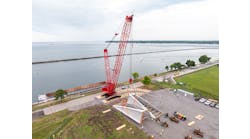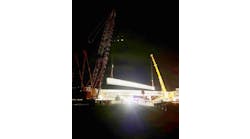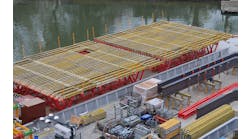The Oregon Department of Transportation (ODOT), using highly alloyed stainless steel reinforcing bar in its concrete structures, is building a bridge in North Bend, Ore., that is expected to provide maintenance-free service for an amazing 120 years—nearly double the service life of the bridge it is replacing.
Frank Nelson, bridge preservation managing engineer for ODOT, figures the taxpayers are getting a huge bargain. When finished by the end of 2003, the bridge will cost approximately $12 million. The stainless steel rebar, utilized in the most critical structural elements, accounts for only 13% of the total bridge cost.
For that small increase, he observed, ODOT will save the cost of bridge replacement in 50 years. That is a sum likely to be $25 million, or at least twice the cost of bridge construction today. As an alternative, the money saved could be used to build another bridge. Meanwhile, the new structure will require little more than routine examination.
The new bridge, carrying U.S. 101 over the Haynes Inlet Slough near the coastal town of Coos Bay, is using what is believed to be more stainless steel rebar than any bridge in North America—362,878 kg or nearly 400 tons. Yet this is not an ordinary stainless steel structure because it had to meet some very challenging requirements for corrosion resistance, strength and site seismicity.
Along the Oregon coast, the marine environment is very hostile to bridges. Salt-laden air and fog from the Pacific Ocean condense under the deck and T-beams of this bridge. Wind blows the chloride-containing moisture underneath the structures, initiating corrosion. Rain washes the chlorides off the road surface, but flushes away nothing below.
ODOT considered stainless-clad bar and epoxy coating of carbon steel rebar, but decided neither possessed sufficient durability or long-term resistance to chloride-induced corrosion. The concrete in which the rebar is embedded will eventually become contaminated with corrosive chlorides.
Extraordinary strength was required of the stainless to facilitate design of the new bridge and to deal with the potentially devastating seismic activity in this area. ODOT specified that the stainless alloy needed must have a minimum yield strength of 75 ksi. That strength level is new to bridge building and substantially higher than the 60 ksi minimum yield strength required of the Type 316LN stainless that was used for rebar in ODOT’s Brush Creek and Smith River bridges replaced a few years ago. In addition, the alloy also had to provide high ductility (25% elongation) so it could be effectively fabricated.
In view of the area’s geological history, Bridge Designer James Bollman had a study done to determine design seismicity and collapse criteria. Ground surface accelerations were intended to forecast a 1,000-year probability seismic event. Ground surface acceleration was calibrated at 1.05 g maximum and peak bedrock acceleration at 0.54 g. The bridge, consequently, has been designed to remain serviceable with only a 10% probability over its lifetime of the site seismicity exceeding the design seismicity.
It was clear that ODOT, its goal set on extending bridge life, wanted this to be its strongest bridge yet. With a higher strength stainless alloy than any ODOT had used to date, the bridge was expected to enjoy an economic advantage of less stainless rebar weight than would have been required using 60 ksi alloy.
Strong alloy
Farwest Steel Corp., Eugene, Ore., steel distributor and rebar manufacturer, has been using Alloy 2205, a duplex stainless steel made by Carpenter Technology Corp., Reading, Pa., and its Talley Metals Technology Inc. subsidiary in Hartsville, S.C. ODOT was counting on Farwest Steel to fabricate the rebar it needed from rolled mill stock.
Carpenter’s 2205 stainless has a duplex microstructure, mixing austenite and ferrite phases, that gives the alloy the required 75 ksi yield strength. This is 25% more yield strength (per ASTM-A-955) than that of austenitic Types 316LN and 304 stainless steels (60 ksi) which are more common candidates for bridge rebar.
In fact, with improvements in hot rolling procedures Carpenter has been able to produce 2205 stainless steel bar in a yield strength range of 85 to 95 ksi. At the same time, while increasing strength, it has managed to exceed the 25% elongation requirement that reflects ductility. That means its 2205 alloy has superior fatigue resistance. Thus, the alloy can better withstand movement of the bridge and stress cycling under heavy truck traffic.
The two Carpenter mills deliver their spiral-ribbed rebar to Farwest Steel in the as-rolled condition, pickled and acid cleaned with surface free of oxides. Carpenter, the first alloy producer to hot roll this high strength product, has provided lengths of up to 30 ft in various sizes from 0.375 to 1.375 in. round (Nos. 3 through 11).
With a careful balance of chromium, molybdenum and nitrogen content, 2205 stainless steel offers superior resistance to chloride pitting, crevice corrosion, stress corrosion cracking and general corrosion in many environments. Its resistance to corrosion is substantially better than that of the Type 316LN stainless ODOT used in previous bridge reconstruction.
Nominal analysis of 2205 alloy is: carbon .03% max., manganese 2% max., phosphorus .03% max., sulfur .02% max., silicon 1% max., chromium 22%, nickel 5.5%, molybdenum 3%, nitrogen .14% and balance iron.
ODOT has selected Carpenter’s 2205 stainless steel to solve the corrosion problems it has experienced in vulnerable concrete coastal bridges. On a regular basis, inspectors used to drill into the concrete for core samples to measure chloride infiltration. They generally found that chloride ions had penetrated the hardened concrete of the most exposed structures, causing serious cracking, delamination and spalling.
Chloride intrusion, accelerated by the tensile cracking of the concrete caused by the relentless load of heavy moving traffic, then produced cracking between concrete and bars along the length of the original carbon steel rebar. With time and more traffic, the cracking caused rust, which occupies a volume greater than that of the original metal. This reaction led to spalling and, with pieces falling away, a further loss of bond between concrete and the steel. As structural members are weakened by corrosion, the increased stress on remaining members could lead to structural failure. With carbon steel rebar, structural failure has occurred in as short a time as 17 years. In contrast, the 2205 alloy is expected to last well over 100 years.
Building east
Along with the duplex stainless alloy rebar, ODOT is using a much larger volume (614,000 kg) of grade 60 uncoated carbon steel rebar in the new bridge for substructure elements where corrosion is less of a problem. The two different steels are, for the most part, being used independently in different structural elements. Where they are used together, the stainless rebar is covered with a polyethylene (PE) sleeve at all points where the dissimilar metals intersect to prevent the possibility of galvanic corrosion.
The new bridge, 773 ft long and 85 ft wide with rising, curving approaches, is a series of three spans of two-hinge cast-in-place concrete deck arches. An estimated 14,000 vehicles a day use the bridge, which carries the busy Oregon Coast Highway over an estaurine inlet. Hamilton Construction Co., Springfield, Ore., is the general contractor in charge of construction.
Hamilton left the older, heavily timbered bridge in place to carry traffic while the east half of the new bridge was completed in Phase 1 of the proj-ect. Now, in Phase 2, the finished east half is carrying traffic, while the old bridge is being removed and the west half is built to join the east half. While the old bridge had two lanes, the replacement bridge will have five.
To increase resistance to corrosive attack on the new bridge, Bollman had all bridge elements above the footings cast with microsilica concrete. This type of concrete is less permeable to corrosive chloride ions than conventional concrete. Carpenter 2205 stainless alloy was selected by Bollman to reinforce the deck, deck support T-beams and the rail on the edges of the bridge.
The deck and T-beams are typically the first to suffer the effects of corrosion because they are thinner than the main support members and subjected to bending forces and dynamic loads from heavy trucks that cause significant stress cycling in both the rebar and concrete. Substructure elements, in compression under service load, do not experience stress cycling under service load into the tensile range. They are, therefore, less susceptible to damage from chloride intrusion.
The arch design harmonizes with Oregon’s other coastal bridges and, in particular, the beautiful nearby Conde McCullough Memorial Bridge. The two-hinge arch design also allows for more slender arch ribs, which enhance the bridge appearance and also help meet the challenging seismic conditions. Without vertical bending, a more slender arch is possible at its support. This allows for smaller and less stiff supporting pedestals and footing, thus less cost for those foundation members.
All concrete members except the arch ends are monolithic, with reinforcement running completely through. This feature enhances the seismic energy absorptive capacity, which is a key element of bridge seismic resistance.
At the end of the ribs, hinges that have been made of 2205 stainless steel plate are submerged in brackish water of the estuary at high tide. These hinges preclude in-plane bending of the arch ribs at their supports for either live or dead load. Pins used with the hinges are made of a non-galling, corrosion-resistant stainless steel.
Coupled only
After Farwest Steel receives hot rolled 2205 alloy rebar from Carpenter, it cuts pieces to specific lengths, bends some (because of the alloy’s good ductility) and adds Lenton taper threads to the ends of the No. 10 bars. The fabricator requires Carpenter to comply with a straightness tolerance of no more than 1-in. deviation over a 5-ft length. Straightness is important because the company cuts a quantity of bar at a time in a tray, butting all the pieces against the same reference plate. The cutoff must produce bars of exactly the same length. Then the fabricated product is strapped in plastic and shipped to Triad Steel Inc., subcontracting ironworker, at the bridge site.
Triad, based in Springfield, Ore., then positions the stainless rebar in forms in accordance with CAD placing drawings provided by Farwest Steel and ODOT. Responsible to Hamilton Construction, Triad then lap splices the Carpenter 2205 alloy rebar with stainless tie wire, or joins lengths with Lenton mechanical couplers that have been made by Erico Inc., Solon, Ohio, from the same Carpenter alloy.
When 2205 duplex stainless rebar is joined by good lapping technique, the lapped joint has developed a yield strength of 75 ksi. However, the Erico Lenton taper threaded 2205 alloy coupler, torqued onto the 2205 alloy rebar threaded by Farwest Steel, has developed an ultimate tensile strength of 100 ksi. In tests, strength as high as 130 ksi UTS has been reached for Lenton. Under new construction codes, there is greater reliance on mechanically coupled rebar to transfer loads and stresses than there is on concrete, which can be adversely affected by salt, chlorides and other environmental conditions.
The Lenton mechanically coupled 2205 stainless rebar has been used extensively in the bottom of the T-beam which supports the bridge deck above the arch. It was chosen by ODOT for this application because its greater strength and corrosion resistance were needed here and also because the coupled rebar, compared with lapped rebar, occupied less of the limited space available.
Slippage must be held to a minimum at the joint between the rebar and coupler because of the perpetual seismic threat and the tensile stress cycling from truck traffic. With the Erico Lenton couplers, slipping motion has been held to .003-in. maximum at half the specified yield strength. This is significantly better than the maximum .01-in. slip allowed by the ODOT specification. No other coupler system tested was found capable of meeting the tight slip specifications for this job.


